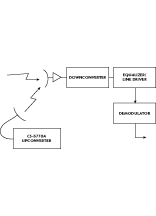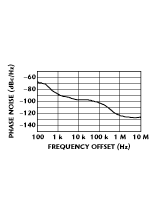A Flexible Upconverter/Signal Generator to Support Communication and Radar Systems
Communication Solutions Inc.
Baltimore, MD
As modulation formats become more complex and communication and radar systems push the edge of technology, timely and cost-effective maintenance of these systems requires sophisticated test equipment. Wider bandwidth, AM and FM modulation, and cleaner and faster synthesizers are required to test these systems. One test system component that challenges the industry is the microwave upconverter/signal generator.
Typically, signal generators used for testing antennas, amplifiers, receivers and simple demodulators do not provide sufficient modulation bandwidth or the necessary resources to test the complete system as a single entity. Recently, special-purpose signal generators that address some of these modulation techniques have been developed and marketed. However, these units are often large and expensive and have limited capability in terms of frequency coverage and modulation types.
An alternate solution to the problem is to generate the desired modulation at relatively low frequencies where low cost digital tools are available to upconvert the signal to the desired frequency. This approach has advantages in terms of cost, size and flexibility. Upconverters also provide the ability to insert a user-supplied signal into the modulation format instead of a prepackaged signal.
The model CS-5770A microwave upconverter/signal generator is a cost-effective remedy to this problem. This new test instrument is a state-of-the-art microwave upconverter/signal source that covers the 0.01 to 20 GHz frequency range with the capability to provide a very low phase noise CW source, pulse modulation or to upconvert complex modulation such as pulse code modulation, spread spectrum and various other types of signals that can be generated with lower frequency instruments.
The upconverter supports modulation formats for both digital and analog communications as well as ground-based, electronic warfare airborne and space-based platform radar systems. The digital communication formats include spread spectrum, quadrature amplitude modulation, AM and quadrature phase-shift keying modulation schemes. The radar applications, which typically require wider bandwidth (greater than 300 MHz) than communication systems, include CW Doppler, pulsed Doppler, chirp-pulsed ranging and synthetic aperture radars. Analog modulation applications include wideband CW- or pulse-chirped signals. FM signal generation is an all-analog process; wideband FM signals may be produced by quadrature modulation followed by frequency multiplication.
Typical Applications
The CS-5770A microwave upconverter is used in multiple configurations to  meet the needs of the system integrator in testing modern, sophisticated systems. In a typical application, the test signal needed for simulation is generated, upconverted to the actual frequency of interest and injected into the system, as shown in Figure 1 .
meet the needs of the system integrator in testing modern, sophisticated systems. In a typical application, the test signal needed for simulation is generated, upconverted to the actual frequency of interest and injected into the system, as shown in Figure 1 .
One application involves recording a collected signal and playing back that signal through a tape recorder/IF converter and the microwave upconverter. This method provides a good simulation, supplying a near-perfect signal to the limit of the test equipment, which, in most cases, is the bandwidth limitation of the tape recorder. The output of the upconverter may be hard-wired into the system or transmitted into the system's antenna. In this manner, the complete system can be verified easily on a routine basis without changing the system configuration.
A second configuration involves sending data into a modulator, providing various modulation formats. The modulation input may be the user's data stream as opposed to a standard pattern, thus providing a microwave link scenario. The source of data has many potential variations.
A microwave link repeater configuration is another alternative. As a temporary configuration, this scenario provides users with an almost instant link capability, allowing them to test a site and replace the units with a permanent configuration at a later time.
Other applications include inducing a chirp simulation with the various parameters of the chirp data provided via digital circuitry or using an arbitrary waveform generator as the signal source. The arbitrary waveform generator technique represents a diverse set of possibilities involving various noise loadings as well as signal types or combinations of the two.
Product Description
 The CS-5770A microwave upconverter/signal generator is a modular, small-volume, high performance unit that accepts signals at either 70, 140 or 160 MHz and translates them into the 0.5 to 20 GHz frequency range with frequency extension options up to 110 GHz, as shown in Figure 2 . An optional 1 GHz IF input can be installed to provide wideband coverage (up to 500 MHz). The instrument provides low group delay and low phase noise to effectively translate signals generated in the IF to a specific frequency in the 0.5 to 20 GHz range. The unit is fully
The CS-5770A microwave upconverter/signal generator is a modular, small-volume, high performance unit that accepts signals at either 70, 140 or 160 MHz and translates them into the 0.5 to 20 GHz frequency range with frequency extension options up to 110 GHz, as shown in Figure 2 . An optional 1 GHz IF input can be installed to provide wideband coverage (up to 500 MHz). The instrument provides low group delay and low phase noise to effectively translate signals generated in the IF to a specific frequency in the 0.5 to 20 GHz range. The unit is fully synthesized with phase noise less than 0.75° RMS (typically less than 0.5° RMS), 100 Hz tuning resolution and phase coherence with an external 10 MHz reference. Differential group delay at the microwave output is typically less than 5 ns over an 80 MHz bandwidth. In addition, the upconverter features a high dynamic range at the output and an optional attenuator provides 1 dB resolution and 119 dB output level control. Table 1 lists the upconverter's key performance specifications and Figure 3 shows the instrument's typical phase noise at 18 GHz. Figure 4 shows the unit's group delay performance at 10 GHz.
synthesized with phase noise less than 0.75° RMS (typically less than 0.5° RMS), 100 Hz tuning resolution and phase coherence with an external 10 MHz reference. Differential group delay at the microwave output is typically less than 5 ns over an 80 MHz bandwidth. In addition, the upconverter features a high dynamic range at the output and an optional attenuator provides 1 dB resolution and 119 dB output level control. Table 1 lists the upconverter's key performance specifications and Figure 3 shows the instrument's typical phase noise at 18 GHz. Figure 4 shows the unit's group delay performance at 10 GHz.
|
Table I | |
|
RF Output Frequency (GHz) |
0.5 to 20 |
|
Output signal level (dBm) |
|
|
Input Signal Level (dBm) (typ) |
-10 |
|
IF-to-RF gain (1 GHz IF input) (dB) |
10 ± 1.5 |
|
Output harmonics (dBc) (max) (at 0 dBm output) |
-30 |
|
Tuning resolution (Hz) |
100 |
|
Output flatness (dB) (p-p max) (70, 140, or 160 MHz IF Input) |
1.5 |
The CS-5770A is housed in a rugged 3.5" x 8.5" x 21.0" rack-mount chassis  and weighs less than 20 lb, depending on the selected options. The AC power requirements are universal input of 90 to 264 V AC, 47 to 63 Hz with power line electromagnetic interference (EMI) filtering and protection via a circuit breaker. The unit is designed to meet the requirements of MIL-STD-461C and includes mechanical shielding techniques such as EMI gasketing and waveguide beyond cutoff hole patterns for cooling. RF connectors are mounted on the rear panel. The 18 to 40 GHz and 40 to 60 GHz extended upconverters weigh approximately 4 lb each.
and weighs less than 20 lb, depending on the selected options. The AC power requirements are universal input of 90 to 264 V AC, 47 to 63 Hz with power line electromagnetic interference (EMI) filtering and protection via a circuit breaker. The unit is designed to meet the requirements of MIL-STD-461C and includes mechanical shielding techniques such as EMI gasketing and waveguide beyond cutoff hole patterns for cooling. RF connectors are mounted on the rear panel. The 18 to 40 GHz and 40 to 60 GHz extended upconverters weigh approximately 4 lb each.
The unit features user-friendly front-panel control that requires little to no training. With built-in attenuation control, the instrument can be operated via an RS-232/RS-422 remote computer interface or local front-panel control. IEEE-488 and Ethernet interfaces can be provided as options.
Conclusion
The CS-5770A microwave upconverter/signal generator enables the user to develop complex modulation signals at a low frequency and upconvert them to a frequency of interest with relative ease. This technique allows either stored signals (analog storage or digital snapshots) to be reconstructed and provided as simulated test signals. The instrument allows the user to carry one wideband upconverter as well as a modulator to the field to create and supply unique test signals for a particular application and to easily change to another modulation format. Ease of tuning, low phase noise and exceptionally wideband frequency coverage make the instrument a good choice for multiple upconversion requirements.
Communication Solutions Inc.,
Baltimore, MD
(410) 574-4557.
